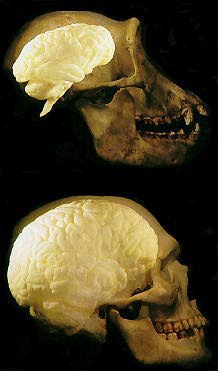Larger Primate Brains
Compared to other animals, primates
have larger brains relative to their body size. The areas of the brain
related to the coordination of the limbs, memory, and vision is increased
in primates compared to other mammals.
The more an animal weighs, the more
of it there is that its brain must control, and so within certain limits
the bigger its brain needs to be. This is true between species, although
not between individual members of a given species. A species with a much
bigger brain for its body weight - especially in its higher brain centers
- has a good chance of being, on some level, smarter. Indeed, for comparable
body- weights, humans tend to have bigger brains than other primates; primates
than other mammals; mammals than birds; birds than fish; and fish than
reptiles. There is some scatter in the data, but the correlation is clear.
It corresponds pretty well to the commonly accepted (by humans, of course)
rank order of animal intelligence. The earliest mammals had significantly
larger brains than their reptilian contemporaries of comparable body weight;
and the earliest primates were similarly well-endowed compared to other mammals. We come from big- brained stock. Adult humans,
who weigh only a little more than adult chimps, nevertheless have brains
three to four times more massive. A human infant a few months old already
has a larger brain than a grownup chimpanzee. It seems very likely that
we are significantly smarter than the chimps because we have a significantly
larger brain - despite the comparable body weights. But the human brain
isn't entirely a proportional scaling up of a chimp brain. There is a little
bit of brain architecture - not much, but some - that humans have and that
other primates at least mainly don't. Significantly, some of it seems to
be related to speech.
compared to other mammals. We come from big- brained stock. Adult humans,
who weigh only a little more than adult chimps, nevertheless have brains
three to four times more massive. A human infant a few months old already
has a larger brain than a grownup chimpanzee. It seems very likely that
we are significantly smarter than the chimps because we have a significantly
larger brain - despite the comparable body weights. But the human brain
isn't entirely a proportional scaling up of a chimp brain. There is a little
bit of brain architecture - not much, but some - that humans have and that
other primates at least mainly don't. Significantly, some of it seems to
be related to speech.
Primates have five individual toes.
All primates, except humans, have a big toe that is positioned on the side
of the foot. In this position, the big toe can act in a way similar to
a thumb. The foot can grasp objects, such as branches and food. The foot
can even hold an orange. Humans on the other hand cannot use their feet
for grasping objects. Our foot is designed for bipedal walking. In order
for us to be good at walking the way we do, our big toe is parallel to
the other toes . The big toe provides balance during each step. When we
climb a tree, our feet are unable to grasp branches the way other primates
can. Therefore, we aren't very good at climbing and spend most of our time
on the ground.
 compared to other mammals. We come from big- brained stock. Adult humans,
who weigh only a little more than adult chimps, nevertheless have brains
three to four times more massive. A human infant a few months old already
has a larger brain than a grownup chimpanzee. It seems very likely that
we are significantly smarter than the chimps because we have a significantly
larger brain - despite the comparable body weights. But the human brain
isn't entirely a proportional scaling up of a chimp brain. There is a little
bit of brain architecture - not much, but some - that humans have and that
other primates at least mainly don't. Significantly, some of it seems to
be related to speech.
compared to other mammals. We come from big- brained stock. Adult humans,
who weigh only a little more than adult chimps, nevertheless have brains
three to four times more massive. A human infant a few months old already
has a larger brain than a grownup chimpanzee. It seems very likely that
we are significantly smarter than the chimps because we have a significantly
larger brain - despite the comparable body weights. But the human brain
isn't entirely a proportional scaling up of a chimp brain. There is a little
bit of brain architecture - not much, but some - that humans have and that
other primates at least mainly don't. Significantly, some of it seems to
be related to speech.